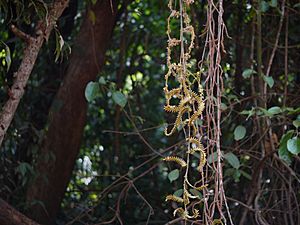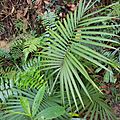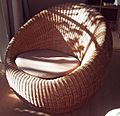Rattan facts for kids
Rattan is a special type of palm plant. It's not like the tall, straight palm trees you might imagine. Instead, rattan plants are climbers! They grow like vines, often reaching high into the trees of tropical forests.
The word "rattan" comes from the Malay word rotan. There are about 600 different kinds, or species, of rattan plants. Most of them grow in the "Old World," which means places like Asia, Africa, and Australia.
Rattan plants are part of a larger group of palms called the Calamoideae subfamily. You might also hear rattan called manila or malacca. These names come from important trading ports, Manila in the Philippines and Malacca City in Malaysia, where rattan was often shipped from. Another name, manau, is used for a specific type of rattan called Calamus manan.
What Makes Rattan Special?
Rattan plants are unique because of how they grow. They have a very flexible, woody stem that helps them climb. Unlike regular trees, rattan doesn't grow thicker in the same way. This makes it more like a liana (a woody vine) than a true wood. Because of this, rattan can grow much faster than most other trees in tropical forests.
Dragon's Blood Resin
Some types of rattan plants produce a special red resin from their fruit. This resin is known as 'Dragon's blood'. It has been used for a long time as a dye, to make varnishes (a clear coating), and in incense (something that smells nice when burned).
Images for kids
-
Calamus thwaitesii growing in southwestern India
-
Young Calamus oblongus subsp. mollis in a forest understory in the Philippines
-
A close-up of the edible scaly fruits and the spiny stem of Calamus rotang in Thailand
-
A young Plectocomia elongata growing freely in Indonesia
-
Wild-harvested rattan canes being treated and dried in Palawan, Philippines
-
A worker harvesting rattan from an old-growth forest in the Philippines
-
Sibat spears from the Philippines
-
Indonesians making rattan furniture, around 1948
-
A craftsman in the Philippines heat bending rattan to make furniture
-
A craftsman weaving a basket from split rattan in Nigeria
See also
 In Spanish: Ratán para niños
In Spanish: Ratán para niños
















